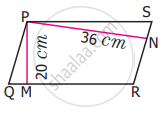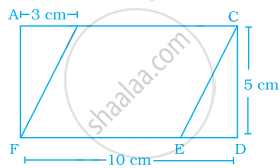Advertisements
Advertisements
Question
Find the missing values.
| Base | Height | Area |
| 18 cm | 5 cm |
Solution
Given: Base 6 = 18 cm
Height h = 5 cm
Area of the parallelogram = b × h sq.units
= 18 × 5 cm2
= 90 cm2
Tabulating the results, we get
| Base | Height | Area |
| 18 cm | 5 cm | 90 cm2 |
APPEARS IN
RELATED QUESTIONS
A parallelogram has sides of 15 cm and 12 cm; if the distance between the 15 cm sides is 6 cm; find the distance between 12 cm sides.
The area of parallelogram whose base 10 m and height 7 m is
In a parallelogram the base is three times its height. If the height is 8 cm then the area is
In a parallelogram PQRS (See the diagram) PM and PN are the heights corresponding to the sides QR and RS respectively. If the area of the parallelogram is 900 sq.cm and the length of PM and PN are 20 cm and 36 cm respectively, find the length of the sides QR and SR
If the base and height of a parallelogram are in the ratio 7 : 3 and the height is 45 cm, then fixed the area of the parallelogram
Find the height of the parallelogram whose base is four times the height and whose area is 576 sq.cm
Find the missing value:
| Base | Height | Area of parallelogram |
| 15.6 cm | ______ | 16.38 cm2 |
In the given figure, area of parallelogram BCEF is ________ cm2 where ACDF is a rectangle.

Perpendicular dropped on the base of a parallelogram from the opposite vertex is known as the corresponding ______ of the base.
If perimeter of two parallelograms are equal, then their areas are also equal.
